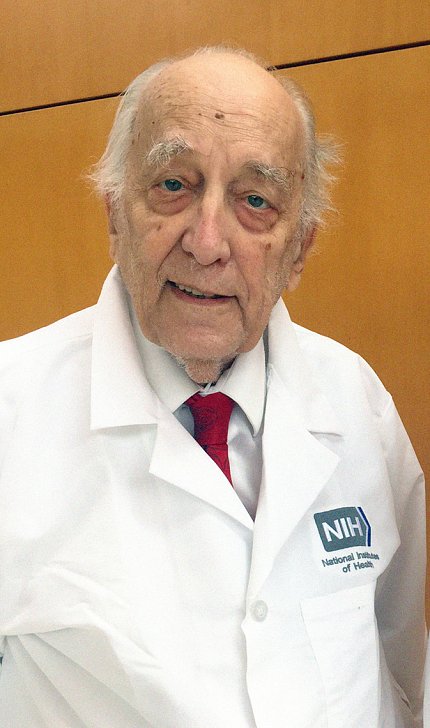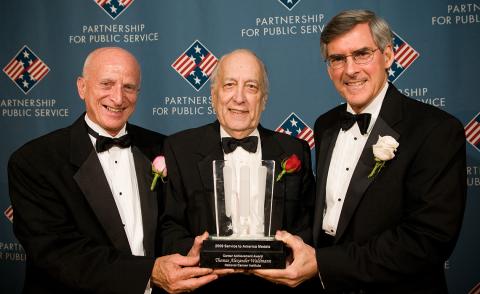‘Giant in the Field’
Renowned Immunologist Waldmann Is Mourned

NIH distinguished investigator Dr. Thomas A. Waldmann, chief emeritus of the Lymphoid Malignancies Branch in the Center for Cancer Research at NCI, died on Sept. 25.
Considered a giant in the field, Waldmann was a renowned immunologist whose more than 60-year career at NCI led to numerous high-impact discoveries that advanced the fields of organ transplantation, autoimmune disease and cancer. He was a leader in the study of cytokines and their receptors and of monoclonal antibodies, now a dominant form of cancer immunotherapy.
He received his M.D. from Harvard Medical School in 1955 and joined NCI in 1956 after residency at Massachusetts General Hospital. At NCI, he started by studying how the body metabolizes proteins, including immunoglobulins, in the blood. By 1959, he had become a senior investigator and his research had expanded to include work with patients with primary immunodeficiency diseases and disorders of lymphatic channels. Waldmann became chief of the Metabolism Branch, now the Lymphoid Malignancies Branch, in 1971.
Waldmann’s pivotal studies revolutionized understanding of the roles played by the interleukin-2 (IL-2) receptor and interleukin-15 (IL-15) receptor cytokine systems in the life and death of T lymphocytes.
In characterizing the first cytokine receptor, IL-2, his team set the stage for understanding the biology and biochemistry of this family of molecules and then demonstrated that antibodies specific for the IL-2 receptor were useful in treating adult T-cell leukemia, prolonging survival of transplant recipients and treating multiple sclerosis.
In 1994, Waldmann and his team co-discovered the cytokine IL-15. Like IL-2, IL-15 triggers the production of immune cells that attack and kill cancer cells. Waldmann’s group initiated the first-in-human IL-15 clinical trial in 2011. Waldmann initiated clinical trials to evaluate IL-15’s capacity to augment antibody-dependent cellular cytotoxicity when administered with tumor directed monoclonal antibodies. The work exemplified his passion for developing therapeutics for cancer and AIDS.
Waldmann is remembered for other accomplishments as well. Prior to 1980, he studied the metabolism of serum proteins, which led him to identify a rare disorder of the gastrointestinal tract now known as Waldmann’s disease. In 1981, he helped treat the first patient with AIDS at NIH. And in 2016, the Food and Drug Administration approved daclizumab, the antibody he discovered, for use in the therapy of relapsing multiple sclerosis.
Waldmann once said in an interview with the Washington Post, “Science is a river. You’re always building on the past. You might be able to turn over a rock and find something exciting; you don’t want to give up and say, ‘This is all there is.’...It’s like planting a fruit tree that has a long duration, and when it comes time to harvest the oranges or whatever, you don’t want to leave.”

Photo: sam kittner/kittner.com
While Waldmann’s many landmark contributions are well known, “his greatest legacy may be the vast number of outstanding scientists in their own right who owe their success at least in part to Tom’s mentoring,” said NCI Vaccine Branch chief Dr. Jay Berzofsky, whom Waldmann mentored for nearly 28 years.
“Tom was the consummate scientist’s scientist,” says Berzofsky. “He was an encyclopedia of knowledge and constantly came up with valuable insights, bringing diverse sources of knowledge to bear on any question. All of us in the branch improved our science as well as our presentations because of Tom’s mentoring. He was a great friend, collaborator and father-figure to his entire scientific family. We will all miss him tremendously.”
“Tom was one of the most influential mentors in my career,” noted Lymphoid Malignancies Branch chief Dr. Louis Staudt. “When I arrived at NCI in 1988, I was a ‘dyed-in-the-wool’ basic scientist, though I had trained in internal medicine. Tom insisted that I attend his clinical rounds every week where I witnessed his deep commitment to patient-oriented research. It took a while to sink in, but years later I found myself following in Tom’s giant footsteps, for which I am grateful.”
“Tom was one of the brightest scientists and clearest thinkers I have ever had the pleasure to work with in my many years at the NIH,” said Dr. Robert Yarchoan, chief of the HIV and AIDS Malignancy Branch. “When I was a fellow in Dr. Waldmann’s branch, I came away with a real sense of how to go back and forth between the lab and the patient and this has been the focus of my career since.”
Waldmann’s career was full of tremendous originality and scientific novelty. He contributed to the acceleration of progress in cancer research that has major implications for future discoveries.
His more than 880 publications and 100-plus named honorary lectures or keynote addresses have had an enduring impact on the work of others and have led to his receipt of countless honors, including but not limited to the HHS Career Achievement Award, the Bristol-Myers Squibb Award for Distinguished Achievement in Cancer Research, the Paul Ehrlich Medal and the Service to America Career Achievement Award.
Waldmann was also a member of several societies, including the National Academy of Sciences, the National Academy of Medicine, the American Academy of Arts and Sciences and the Hungarian Academy of Sciences. He was an honorary fellow of the Royal Society of the Medical Sciences (U.K.). Moreover, Waldmann was an enthusiastic photographer and former president of the NIH Camera Club.
Waldmann was predeceased by his wife of 62 years, Dr. Katharine Spreng Waldmann. He is survived by his children Richard, Robert and Carol and seven grandchildren. In lieu of flowers, the family requests donations to a memorial fund to benefit the International Medical Corps.
Waldmann’s public obituary is posted at www.pumphreyfuneralhome.com/obituaries/Dr-Thomas-Alexander-Waldmann?obId=22538215.
